Hey all,
are there meanwhile any experiences with this interesting driver?
At least the ribbon tweeters LT6 and LT2 from Radian have been tested by Voice Coil Magazine with really promising results.
Would be great if the LM8K is on a similar level
Best regards
Matthias
are there meanwhile any experiences with this interesting driver?
At least the ribbon tweeters LT6 and LT2 from Radian have been tested by Voice Coil Magazine with really promising results.
Voice Coil said:Note that as with the Radian LT6, the LT2 has an extremely low third-harmonic level.
Would be great if the LM8K is on a similar level
Best regards
Matthias
Hi,
I got 16 pieces about 3 months ago. My initial plan was to create 4way line arrays using woofers from my previous setup (Eminence Deltalite II 2515 + Faital Pro 10FE200) and replacing single NEO10+NEO3 combo with LM8K + tweeter array. This is my previous setup:
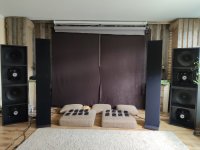
At first I replaced baffled NEO10 with LM8K hanging in free air to play within the same bandwidth (600hz - 3khz). Although the LM8K needed some equalizing, it was able to keep up with NEO10 without sounding thin. I didn't try to lower crossover point below 500hz, because it would require too much equalizing. This shouldn't be problem if I would use a baffle. Upper limit that sounded acceptable for me was ~4khz, but 3khz for pairing it with NEO3 were simply better because of better vertical dispersion of tweeter.
Free air measurement of LM8K:
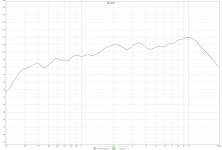
After playing with successful matched pair of LM8K (first 2 drivers I luckily took measured almost identical), I measured other drivers. Here comes a bit of disappointment. The difference in sound level between most and least sensitive ones were about 2,5db. Here you can see all of them together:
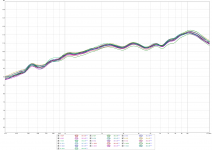
Then I started to combine best matching drivers to create pairs I could put in the middle of line. After finding 5 very close matching pairs, I felt relieved. The sixth were also quite acceptable within planned bandwidth and the rest two pairs gone to both ends of lines.
Next step - creating line arrays. I made some mountings attached to my woofer baffles to hang 8 drivers in each side. And this is how my prototypes look like:
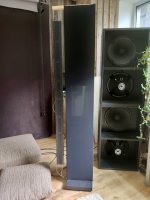
I also added single NEO3 in each side to find the best point for tweeter line array. Later I got also a pair of Dayton PTMini-6 hoping for much cheaper tweeter line option. After weeks of experimentation I found the best crossover point to be about 7-8khz and almost ordered a bunch of tweeters. But then I tried to equalize top end of LM8Ks to match the response of tweeters. Few weeks passed again trying to justify my need for tweeter line array switching forth and back between setups with NEO3, PTMini and without tweeter. Though tweeterless setup coudn't compete in smoothness of top octave measurements, I had to admit that it had more coherent overall sounding. So I finally gave up on idea building a tweeter line array. Now I'm using LM8K for very wide bandwidth starting from 350hz. Sometimes when I want more louder and beefier sound I switch crossover point to 800hz, but the overall sound is noticeably cleaner with 350hz point. Below is off-axis measurements of LM8K line array at 2m distance in my room.
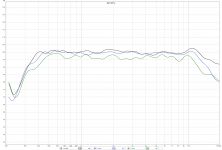
I got 16 pieces about 3 months ago. My initial plan was to create 4way line arrays using woofers from my previous setup (Eminence Deltalite II 2515 + Faital Pro 10FE200) and replacing single NEO10+NEO3 combo with LM8K + tweeter array. This is my previous setup:

At first I replaced baffled NEO10 with LM8K hanging in free air to play within the same bandwidth (600hz - 3khz). Although the LM8K needed some equalizing, it was able to keep up with NEO10 without sounding thin. I didn't try to lower crossover point below 500hz, because it would require too much equalizing. This shouldn't be problem if I would use a baffle. Upper limit that sounded acceptable for me was ~4khz, but 3khz for pairing it with NEO3 were simply better because of better vertical dispersion of tweeter.
Free air measurement of LM8K:

After playing with successful matched pair of LM8K (first 2 drivers I luckily took measured almost identical), I measured other drivers. Here comes a bit of disappointment. The difference in sound level between most and least sensitive ones were about 2,5db. Here you can see all of them together:

Then I started to combine best matching drivers to create pairs I could put in the middle of line. After finding 5 very close matching pairs, I felt relieved. The sixth were also quite acceptable within planned bandwidth and the rest two pairs gone to both ends of lines.
Next step - creating line arrays. I made some mountings attached to my woofer baffles to hang 8 drivers in each side. And this is how my prototypes look like:

I also added single NEO3 in each side to find the best point for tweeter line array. Later I got also a pair of Dayton PTMini-6 hoping for much cheaper tweeter line option. After weeks of experimentation I found the best crossover point to be about 7-8khz and almost ordered a bunch of tweeters. But then I tried to equalize top end of LM8Ks to match the response of tweeters. Few weeks passed again trying to justify my need for tweeter line array switching forth and back between setups with NEO3, PTMini and without tweeter. Though tweeterless setup coudn't compete in smoothness of top octave measurements, I had to admit that it had more coherent overall sounding. So I finally gave up on idea building a tweeter line array. Now I'm using LM8K for very wide bandwidth starting from 350hz. Sometimes when I want more louder and beefier sound I switch crossover point to 800hz, but the overall sound is noticeably cleaner with 350hz point. Below is off-axis measurements of LM8K line array at 2m distance in my room.

Last edited:
Hi Darkheart,
this is an amazing and very interesting project, thank you for sharing it with us.
I understood, that you cannot really compare your old BG Neo10 system with the new LM8k system as you are upgrading from a single Neo10 to a line array of 8 LM8K per side.
However, did you make any direct comparisons between the Neo10 and a single LM8K, e.g. subjective sound quality, distorsion measurements etc.?
I also consider the LM8K as a potential replacement for my Neo10, which I am using as a single naked driver at the moment, with a Mundorf AMT 25D1.1 as a tweeter (fantastic tweeter by the way).
So any experience, which compares the Neo 10 and the LM8K is highly appreciated
I assume, the build quality of the LM8K is beyond any doubt?
Best regards
Matthias
P.S. Please keep us updated about your project!
this is an amazing and very interesting project, thank you for sharing it with us.
I understood, that you cannot really compare your old BG Neo10 system with the new LM8k system as you are upgrading from a single Neo10 to a line array of 8 LM8K per side.
However, did you make any direct comparisons between the Neo10 and a single LM8K, e.g. subjective sound quality, distorsion measurements etc.?
I also consider the LM8K as a potential replacement for my Neo10, which I am using as a single naked driver at the moment, with a Mundorf AMT 25D1.1 as a tweeter (fantastic tweeter by the way).
So any experience, which compares the Neo 10 and the LM8K is highly appreciated
I assume, the build quality of the LM8K is beyond any doubt?
Best regards
Matthias
P.S. Please keep us updated about your project!
Hi Matty,
What are your crossover points for NEO10?
As I wrote, I tried it also as a single free hanging driver in place of NEO10 between 600hz and 3khz. The sound was very similar and so were AFR measurements. LM8K was about 2db more sensitive. I didn't measure distortion. I don't think the LM8K would be a great upgrade to NEO10. Actually LM8K is more like NEO8S. It won't play as low as NEO10, but could be crossed higher heaving better vertical and horizontal dispersion. I had an email conversation with Radian Audio and they said they are also working on a new 10inch driver LM10 which will be similar in performance to NEO10.
What are your crossover points for NEO10?
As I wrote, I tried it also as a single free hanging driver in place of NEO10 between 600hz and 3khz. The sound was very similar and so were AFR measurements. LM8K was about 2db more sensitive. I didn't measure distortion. I don't think the LM8K would be a great upgrade to NEO10. Actually LM8K is more like NEO8S. It won't play as low as NEO10, but could be crossed higher heaving better vertical and horizontal dispersion. I had an email conversation with Radian Audio and they said they are also working on a new 10inch driver LM10 which will be similar in performance to NEO10.
Hi Darkheart,
I'm still experimenting with the xover frequencies.
My goal is a good horizontal directivity, which somehow limits me in the usage of the upper range of the drivers.
At the moment, I am crossing over at 350Hz and 2100Hz
2100Hz, because the Neo10 is losing his controlled and homogenous behaviour above this frequency, when being used as a dipole.
350Hz, because, I wanted to use the Neo10 as low as possible.
This was - amongst other things - because I think, integrating the Neo10 with the woofers is crucial for the overall result.
In my experience, using a huge woofer and crossing it over to high with the Neo10 (or similar drivers), does not sound good.
I experimented with an Acoustic Elegance Dipole 18 alone and even with a Dipole 18 for the lowest frequences, supported by a Accuton AS250 between 80 and 350Hz, but with both solutions I was not really happy.
Last week I changed my configuration and I'm now using the Dipole 18 up to 100Hz and six SB Acoustics Satori MW16P per side between 100Hz and 350Hz.
This was the game changer for me. Using a couple of small, light drivers below the Neo10 harmonizes much better with each other, giving me a much tighter sounding midbass, even on low volume levels, which complements very nice with the level of detail a driver like the Neo10 provides.
As the Satori MW16P is said to be a very good midrange driver as well, this will give me the opportunity to experiment with higher crossover frequencies.
If that works, maybe a LM8K could be the better choice for my concept, as its width is only 8.9 cm or something.
The next weeks will show me in which direction I will go
By the way - thank you very much about the information from Radian about their plans to build an LM10. This could be THE alternative for all of us, who really like the Neo10, which is hard to acquire nowadays.
Best regards
Matthias
I'm still experimenting with the xover frequencies.
My goal is a good horizontal directivity, which somehow limits me in the usage of the upper range of the drivers.
At the moment, I am crossing over at 350Hz and 2100Hz
2100Hz, because the Neo10 is losing his controlled and homogenous behaviour above this frequency, when being used as a dipole.
350Hz, because, I wanted to use the Neo10 as low as possible.
This was - amongst other things - because I think, integrating the Neo10 with the woofers is crucial for the overall result.
In my experience, using a huge woofer and crossing it over to high with the Neo10 (or similar drivers), does not sound good.
I experimented with an Acoustic Elegance Dipole 18 alone and even with a Dipole 18 for the lowest frequences, supported by a Accuton AS250 between 80 and 350Hz, but with both solutions I was not really happy.
Last week I changed my configuration and I'm now using the Dipole 18 up to 100Hz and six SB Acoustics Satori MW16P per side between 100Hz and 350Hz.
This was the game changer for me. Using a couple of small, light drivers below the Neo10 harmonizes much better with each other, giving me a much tighter sounding midbass, even on low volume levels, which complements very nice with the level of detail a driver like the Neo10 provides.
As the Satori MW16P is said to be a very good midrange driver as well, this will give me the opportunity to experiment with higher crossover frequencies.
If that works, maybe a LM8K could be the better choice for my concept, as its width is only 8.9 cm or something.
The next weeks will show me in which direction I will go
By the way - thank you very much about the information from Radian about their plans to build an LM10. This could be THE alternative for all of us, who really like the Neo10, which is hard to acquire nowadays.
Best regards
Matthias
Matty, I believe you would be able to cross your tweeter at 3500hz at least with LM8K, but I wouldn't recommend lower point below 500hz in your configuration. Please, try to cross Satori drivers up to about 800hz. Never used them, but I believe they are excellent open baffle drivers. 6 per side should give you some nice line array behaviour, distortion should also be low enough and maybe they will have a better performance than NEO10 at lower midrange.
Thanks for your suggestion.
Yesterday I tried out to change the crossover frequency from 350Hz to 600Hz.
800Hz was a little bit to high for me in the moment, because as I am already crossing over the Neo10 at 2000Hz to the tweeter, the range in which I would have used it, would have been a little bit to small.
Changing the upper frequency as well would have been to much effort for this evening.
(Im using Acourate / Acourate Convolver with FIR Filters, which basically gives me the opportunity to change and compare filters quite fast and comfortable. However, it is a bunch of steps to be done, until you have a working 4-way crossover.) And if you want to keep horizontal CD behaviour, the Neo10 as a naked driver is limited to somewhat near above 2000Hz.
The little experiment was successful, as I did not get the impression, that I lose details or anything else when crossing over a bit higher. Changes in sound have been subtile, after carefully optimizing the new filter to make sure, that the overall frequency response matches to the old filters.
So, proof of concept of using a couple of MW16P together with a single ribbon midrange with the chosen xover frequency has been successful for me.
This brings me back to the LM8K.
Perhaps it will be the better choice for my concept because it should be easier and more flexible to be integrated with the tweeter (always keeping the horizontal constant directivity idea in mind).
However, I am getting really curious about the LM10 as well.
Did Radian mention, when they plan to launch it?
Yesterday I tried out to change the crossover frequency from 350Hz to 600Hz.
800Hz was a little bit to high for me in the moment, because as I am already crossing over the Neo10 at 2000Hz to the tweeter, the range in which I would have used it, would have been a little bit to small.
Changing the upper frequency as well would have been to much effort for this evening.
(Im using Acourate / Acourate Convolver with FIR Filters, which basically gives me the opportunity to change and compare filters quite fast and comfortable. However, it is a bunch of steps to be done, until you have a working 4-way crossover.) And if you want to keep horizontal CD behaviour, the Neo10 as a naked driver is limited to somewhat near above 2000Hz.
The little experiment was successful, as I did not get the impression, that I lose details or anything else when crossing over a bit higher. Changes in sound have been subtile, after carefully optimizing the new filter to make sure, that the overall frequency response matches to the old filters.
So, proof of concept of using a couple of MW16P together with a single ribbon midrange with the chosen xover frequency has been successful for me.
This brings me back to the LM8K.
Perhaps it will be the better choice for my concept because it should be easier and more flexible to be integrated with the tweeter (always keeping the horizontal constant directivity idea in mind).
However, I am getting really curious about the LM10 as well.
Did Radian mention, when they plan to launch it?
Nice to hear, your experiment was successful.
Radian didn't mention anything about launch date of LM10. But with drivers like MW16P and your idea of constant horizontal directivity, I would clearly recommend LM8K or NEO8S if you can find a pair. There is no need for LM10, if you find your woofers are good up to 600hz.
Radian didn't mention anything about launch date of LM10. But with drivers like MW16P and your idea of constant horizontal directivity, I would clearly recommend LM8K or NEO8S if you can find a pair. There is no need for LM10, if you find your woofers are good up to 600hz.
Ok, this is a statement. 
But comprehensible for me.
Seems like, that I have to try out the LM8K the next time.
The Neo8s is unobtainable at the moment, so no real alternative.
How about the build quality of the LM8K?
The connectors of the Neo10 are a little bit fragile in my opinion for example.
Is this solved in a better way with the LM8K?
But comprehensible for me.
Seems like, that I have to try out the LM8K the next time.
The Neo8s is unobtainable at the moment, so no real alternative.
How about the build quality of the LM8K?
The connectors of the Neo10 are a little bit fragile in my opinion for example.
Is this solved in a better way with the LM8K?
Last edited:
I've got the new GRS planar drivers, an LMK8 plus original neo 8pdr, S and neo 10 all to be tested in a big comparison. Just waiting for the Radian driver to arrive. Should be helpful to compare them all at once under the same conditions.
New planar drivers at Parts Express
Greg
New planar drivers at Parts Express
Greg
Ok, this is a statement.
But comprehensible for me.
Seems like, that I have to try out the LM8K the next time.
The Neo8s is unobtainable at the moment, so no real alternative.
How about the build quality of the LM8K?
The connectors of the Neo10 are a little bit fragile in my opinion for example.
Is this solved in a better way with the LM8K?
I believe build quality is good. Radian also claims they are weather proof. Connectors look same as BG NEO's, but I'm not sure if it's about quality, it's more about technology. I wouldn't solder them anyway, I use connectors for that.
That would be a great comparision! Subscribed and looking forward to see your test results.I've got the new GRS planar drivers, an LMK8 plus original neo 8pdr, S and neo 10 all to be tested in a big comparison. Just waiting for the Radian driver to arrive. Should be helpful to compare them all at once under the same conditions.
New planar drivers at Parts Express
Greg
Yes, for me in my setup it's acceptable, but if I bought a pair and would receive a combination of most sensitive and least sensitive ones, I wouldn't be satisfied with such a sensitivity difference.Nice to see that the curves are consistent even though sensitivity is a bit off.
Looks like it can be eq'd flat to 20khz. Off axis in the top octave is better than I expected.
I didn't expect off-axis to be so good also. It was a big relief to realize I don't need to spend extra money for tweeter line and amplifier.
Last edited:
- Home
- Loudspeakers
- Multi-Way
- Radian Audio LM8K